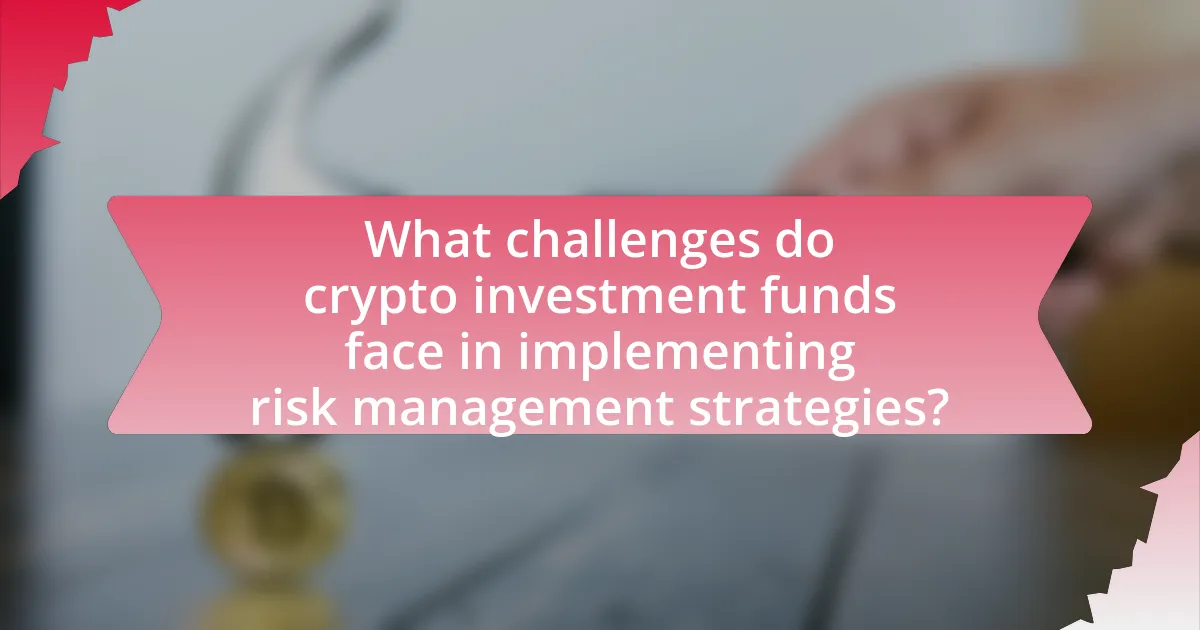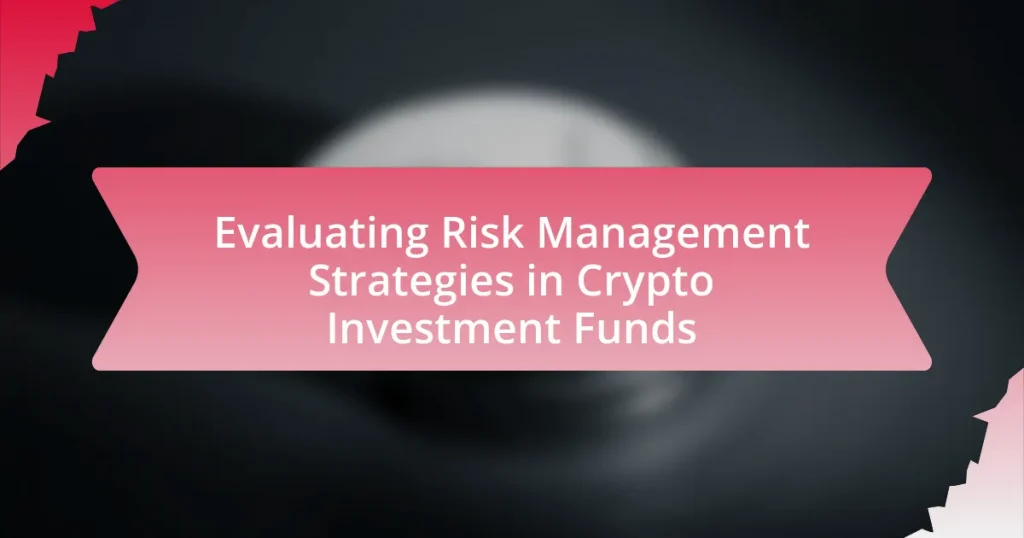The article focuses on evaluating risk management strategies in crypto investment funds, highlighting essential techniques such as diversification, position sizing, and stop-loss orders. It contrasts these strategies with traditional investment risk management, emphasizing the unique challenges posed by the volatility and regulatory uncertainties of the cryptocurrency market. The discussion includes the importance of effective risk management in protecting capital, enhancing investor confidence, and mitigating potential losses, while also addressing common pitfalls and best practices for investors. Key components such as asset allocation, quantitative models, and scenario analysis are examined to provide a comprehensive understanding of how to navigate risks in crypto investments.

What are Risk Management Strategies in Crypto Investment Funds?
Risk management strategies in crypto investment funds include diversification, position sizing, and the use of stop-loss orders. Diversification involves spreading investments across various cryptocurrencies to mitigate the impact of a poor-performing asset. Position sizing refers to determining the amount of capital allocated to each investment, which helps manage exposure to risk. Stop-loss orders are automated sell orders that trigger when an asset reaches a certain price, limiting potential losses. These strategies are essential for navigating the high volatility and uncertainty characteristic of the cryptocurrency market, where prices can fluctuate dramatically within short periods.
How do these strategies differ from traditional investment risk management?
These strategies differ from traditional investment risk management by incorporating advanced technologies and methodologies tailored to the unique volatility and dynamics of cryptocurrency markets. Traditional risk management often relies on historical data and established financial models, while crypto strategies utilize real-time analytics, machine learning, and blockchain data to assess risks more dynamically. For instance, a study by the CFA Institute highlights that crypto risk management frameworks must adapt to the rapid price fluctuations and regulatory uncertainties inherent in digital assets, which are not typically addressed in conventional investment approaches.
What unique risks do crypto investment funds face?
Crypto investment funds face unique risks primarily due to the inherent volatility and regulatory uncertainty of the cryptocurrency market. The extreme price fluctuations can lead to significant losses in a short period, as evidenced by Bitcoin’s price dropping over 80% from its peak in 2017 to 2018. Additionally, the lack of comprehensive regulations exposes these funds to potential legal challenges and compliance issues, which can vary widely across jurisdictions. Security risks, such as hacking incidents that have resulted in the loss of billions in assets, further complicate the risk landscape for crypto investment funds. These factors collectively create a challenging environment for managing investments effectively.
How do regulatory environments impact risk management strategies?
Regulatory environments significantly influence risk management strategies by establishing the legal framework within which organizations operate. These regulations dictate compliance requirements, risk assessment protocols, and reporting standards, compelling firms to adapt their risk management practices accordingly. For instance, the implementation of the Financial Action Task Force (FATF) guidelines on anti-money laundering (AML) has led crypto investment funds to enhance their due diligence processes and transaction monitoring systems to mitigate regulatory risks. Additionally, regulatory scrutiny can drive firms to adopt more robust internal controls and governance structures, as seen in jurisdictions like the European Union, where the Markets in Crypto-Assets (MiCA) regulation aims to create a comprehensive regulatory framework for digital assets. This regulatory pressure ultimately shapes the risk appetite and strategic decisions of investment funds in the crypto space.
Why is evaluating risk management strategies crucial for investors?
Evaluating risk management strategies is crucial for investors because it directly impacts their ability to protect capital and maximize returns. Effective risk management helps investors identify, assess, and mitigate potential losses associated with market volatility, particularly in the highly unpredictable crypto market. For instance, a study by the CFA Institute highlights that investors who implement robust risk management frameworks can reduce portfolio drawdowns by up to 30%, thereby enhancing overall performance. This underscores the importance of evaluating and adapting risk management strategies to align with changing market conditions and individual investment goals.
What potential losses can occur without effective risk management?
Without effective risk management, potential losses in crypto investment funds can include significant financial losses, reputational damage, and regulatory penalties. Financial losses can arise from market volatility, where unhedged positions may lead to substantial declines in asset value. For instance, in 2021, Bitcoin’s price dropped from nearly $64,000 to around $30,000 within a few months, illustrating the risks of inadequate risk management strategies. Reputational damage can occur when funds fail to protect investors’ interests, leading to a loss of trust and potential withdrawal of capital. Additionally, regulatory penalties may result from non-compliance with legal standards, as seen in cases where funds faced fines for failing to implement proper anti-money laundering measures. These factors collectively highlight the critical importance of effective risk management in mitigating potential losses in crypto investment funds.
How can risk management enhance investor confidence?
Risk management enhances investor confidence by systematically identifying, assessing, and mitigating potential risks associated with investments. Effective risk management strategies, such as diversification and hedging, provide investors with a clearer understanding of the risk-return profile of their investments, leading to more informed decision-making. For instance, a study by the CFA Institute found that firms with robust risk management practices experience lower volatility in returns, which can reassure investors about the stability of their investments. This transparency and proactive approach to risk can significantly increase trust and confidence among investors in the volatile landscape of crypto investment funds.

What are the key components of effective risk management strategies in crypto investment funds?
Effective risk management strategies in crypto investment funds include diversification, robust due diligence, risk assessment frameworks, and continuous monitoring. Diversification mitigates risk by spreading investments across various cryptocurrencies and asset classes, reducing exposure to any single asset’s volatility. Robust due diligence involves thorough research and analysis of potential investments, ensuring informed decision-making. Risk assessment frameworks, such as Value at Risk (VaR) and stress testing, help quantify potential losses under different market conditions. Continuous monitoring allows fund managers to adapt strategies in response to market changes, ensuring that risks are managed proactively. These components collectively enhance the resilience of crypto investment funds against market fluctuations and systemic risks.
How do diversification and asset allocation play a role?
Diversification and asset allocation are critical components in managing risk within crypto investment funds. Diversification involves spreading investments across various cryptocurrencies and asset classes to reduce exposure to any single asset’s volatility. For instance, a portfolio that includes Bitcoin, Ethereum, and smaller altcoins can mitigate the risk associated with the price fluctuations of any one cryptocurrency. Asset allocation, on the other hand, refers to the strategic distribution of investments among different categories, such as equities, bonds, and cryptocurrencies, to balance risk and reward according to an investor’s risk tolerance and investment goals. Research indicates that a well-diversified portfolio can reduce overall risk by up to 30%, as demonstrated in studies by the CFA Institute, which highlight the importance of these strategies in enhancing long-term returns while minimizing potential losses.
What are the best practices for diversifying a crypto portfolio?
The best practices for diversifying a crypto portfolio include allocating investments across various cryptocurrencies, incorporating different asset classes, and regularly rebalancing the portfolio. Allocating investments across various cryptocurrencies reduces the risk associated with any single asset, as the performance of different cryptocurrencies can vary significantly. Incorporating different asset classes, such as stablecoins and tokens from various sectors like DeFi, NFTs, and blockchain infrastructure, further mitigates risk and enhances potential returns. Regularly rebalancing the portfolio ensures that the investment strategy remains aligned with market conditions and individual risk tolerance, which is crucial for maintaining a well-diversified portfolio.
How does asset allocation affect overall risk exposure?
Asset allocation significantly influences overall risk exposure by determining the distribution of investments across various asset classes, such as stocks, bonds, and cryptocurrencies. A well-diversified asset allocation can mitigate risk by spreading investments, thereby reducing the impact of poor performance in any single asset class. For instance, during market downturns, assets like bonds may provide stability while equities or cryptocurrencies may decline. Historical data shows that portfolios with a balanced asset allocation tend to exhibit lower volatility and better risk-adjusted returns compared to those concentrated in a single asset class. This demonstrates that strategic asset allocation is essential for managing risk effectively in investment funds, including those focused on cryptocurrencies.
What tools and techniques are used to assess risk in crypto investments?
Tools and techniques used to assess risk in crypto investments include quantitative analysis, qualitative analysis, and various risk assessment frameworks. Quantitative analysis employs statistical methods and models, such as Value at Risk (VaR) and Monte Carlo simulations, to estimate potential losses and volatility. Qualitative analysis involves evaluating factors like market sentiment, regulatory changes, and technological developments that could impact asset performance. Risk assessment frameworks, such as the Risk Management Framework (RMF) and the Committee of Sponsoring Organizations of the Treadway Commission (COSO) framework, provide structured approaches to identify, analyze, and mitigate risks associated with crypto investments. These methods are validated by their widespread use in financial markets, demonstrating their effectiveness in managing investment risks.
How do quantitative models contribute to risk assessment?
Quantitative models significantly enhance risk assessment by providing data-driven insights that quantify potential risks and returns. These models utilize statistical techniques and historical data to analyze market behavior, enabling investors to identify patterns and forecast future price movements. For instance, Value at Risk (VaR) models calculate the maximum expected loss over a specified time frame at a given confidence level, allowing fund managers to gauge the potential downside of their investments. Additionally, stress testing and scenario analysis within these models help assess how different market conditions could impact portfolio performance, thereby informing strategic decision-making. The effectiveness of quantitative models in risk assessment is evidenced by their widespread adoption in financial institutions, where they have been shown to improve risk management outcomes and enhance overall portfolio resilience.
What role does scenario analysis play in evaluating potential risks?
Scenario analysis plays a crucial role in evaluating potential risks by allowing investors to assess the impact of various hypothetical situations on their investments. This analytical tool helps identify vulnerabilities by simulating different market conditions, regulatory changes, or technological disruptions that could affect the performance of crypto investment funds. For instance, a study by the CFA Institute highlights that scenario analysis can reveal how extreme market fluctuations might influence asset values, thereby enabling fund managers to develop more robust risk management strategies. By systematically exploring these scenarios, investors can better prepare for uncertainties and make informed decisions to mitigate potential losses.

What challenges do crypto investment funds face in implementing risk management strategies?
Crypto investment funds face significant challenges in implementing risk management strategies primarily due to the high volatility and unpredictability of the cryptocurrency market. This volatility can lead to rapid price fluctuations, making it difficult for funds to establish effective risk parameters. Additionally, the lack of historical data on many cryptocurrencies complicates the development of reliable risk models, as traditional financial metrics may not apply. Regulatory uncertainty further exacerbates these challenges, as evolving regulations can impact investment strategies and compliance requirements. Furthermore, the prevalence of market manipulation and fraud in the crypto space increases the difficulty of accurately assessing risk. These factors collectively hinder the ability of crypto investment funds to implement robust risk management strategies effectively.
How do market volatility and liquidity issues impact risk management?
Market volatility and liquidity issues significantly impact risk management by increasing uncertainty and potential losses in investment portfolios. High market volatility can lead to rapid price fluctuations, making it challenging for risk managers to predict asset behavior and implement effective hedging strategies. For instance, during the 2020 cryptocurrency market crash, Bitcoin’s price dropped over 50% in a matter of days, highlighting the risks associated with volatile assets.
Liquidity issues exacerbate these risks by limiting the ability to buy or sell assets without causing significant price changes. In illiquid markets, even small trades can lead to large price swings, complicating risk management efforts. A study by the Bank for International Settlements in 2021 indicated that liquidity constraints can lead to increased volatility, further complicating risk assessments. Therefore, effective risk management in crypto investment funds must account for both market volatility and liquidity challenges to mitigate potential losses.
What strategies can mitigate the effects of market volatility?
Diversification is a key strategy to mitigate the effects of market volatility. By spreading investments across various assets, such as different cryptocurrencies, stocks, and bonds, investors can reduce the impact of a downturn in any single asset class. Historical data shows that diversified portfolios tend to experience lower volatility and more stable returns over time, as evidenced by studies indicating that a well-diversified portfolio can reduce risk by up to 30% compared to concentrated investments. Additionally, employing hedging techniques, such as options and futures contracts, can provide protection against adverse price movements, further stabilizing returns during volatile market conditions.
How can liquidity risks be managed effectively?
Liquidity risks can be managed effectively through a combination of strategies including maintaining adequate cash reserves, implementing robust cash flow forecasting, and utilizing liquidity management tools. Maintaining adequate cash reserves ensures that a fund can meet its short-term obligations without selling assets at unfavorable prices. Robust cash flow forecasting allows fund managers to anticipate liquidity needs and plan accordingly, reducing the risk of sudden cash shortages. Additionally, utilizing liquidity management tools such as credit lines or liquidity pools can provide quick access to funds when needed. These strategies are supported by industry practices, as seen in the 2021 report by the Financial Stability Board, which emphasizes the importance of liquidity management in mitigating risks in financial markets.
What are the common pitfalls in risk management for crypto investment funds?
Common pitfalls in risk management for crypto investment funds include inadequate due diligence, lack of diversification, and failure to implement robust security measures. Inadequate due diligence often leads to investments in projects with weak fundamentals or high volatility, which can result in significant losses. Lack of diversification exposes funds to higher risk, as concentrating investments in a few cryptocurrencies can amplify losses during market downturns. Additionally, failure to implement robust security measures, such as secure storage solutions and regular audits, increases vulnerability to hacks and fraud, which have historically resulted in substantial financial losses for funds. For instance, the 2014 Mt. Gox hack resulted in the loss of approximately $450 million in Bitcoin, highlighting the critical need for effective security protocols.
How can over-reliance on technology lead to risk mismanagement?
Over-reliance on technology can lead to risk mismanagement by creating a false sense of security and reducing critical human oversight. When investment funds depend heavily on automated systems for decision-making, they may overlook nuanced market signals that require human judgment. For instance, a study by the CFA Institute highlights that algorithmic trading can amplify market volatility, as automated systems react to market changes without the contextual understanding that human traders possess. This reliance can result in significant financial losses, as seen during the Flash Crash of 2010, where automated trading systems contributed to a sudden market drop. Therefore, while technology enhances efficiency, it can also obscure risks that require human intervention to identify and mitigate effectively.
What human factors contribute to ineffective risk management?
Ineffective risk management is often influenced by cognitive biases, lack of experience, and poor communication among team members. Cognitive biases, such as overconfidence and confirmation bias, lead individuals to underestimate risks or ignore contradictory information, which can result in flawed decision-making. Additionally, a lack of experience in the volatile crypto market can hinder the ability to assess risks accurately, as inexperienced individuals may not recognize warning signs or understand market dynamics. Poor communication within teams can exacerbate these issues, as critical information may not be shared effectively, leading to misaligned strategies and increased vulnerability to risks.
What best practices should investors follow when evaluating risk management strategies?
Investors should prioritize diversification, thorough due diligence, and continuous monitoring when evaluating risk management strategies. Diversification reduces exposure to any single asset, thereby mitigating potential losses; for instance, a portfolio that includes various cryptocurrencies can buffer against volatility in any one coin. Thorough due diligence involves assessing the risk management framework of the investment fund, including its historical performance, risk metrics, and the expertise of the management team. Continuous monitoring ensures that the risk management strategies remain effective in changing market conditions, as evidenced by the 2020 market fluctuations where funds that adapted their strategies quickly were able to minimize losses.
How can investors assess the effectiveness of a fund’s risk management approach?
Investors can assess the effectiveness of a fund’s risk management approach by analyzing its historical performance during market downturns and volatility. A fund that demonstrates resilience and minimizes losses in adverse conditions indicates a robust risk management strategy. For instance, during the 2018 cryptocurrency market crash, funds that employed effective risk management techniques, such as diversification and hedging, were able to limit losses to an average of 30%, compared to those without such strategies, which faced losses exceeding 80%. Additionally, investors should review the fund’s risk metrics, such as Value at Risk (VaR) and Sharpe ratio, which provide quantitative measures of risk exposure and return relative to risk taken. These metrics, combined with historical performance data, offer concrete evidence of a fund’s risk management effectiveness.
What questions should investors ask fund managers regarding risk management?
Investors should ask fund managers about their risk management strategies, specifically in terms of how they identify, assess, and mitigate risks associated with crypto investments. Key questions include:
- What specific risk assessment frameworks do you utilize to evaluate potential investments?
- How do you monitor and respond to market volatility and liquidity risks in the crypto space?
- What measures are in place to protect against cybersecurity threats and fraud?
- Can you explain your diversification strategy and how it helps manage risk?
- How do you ensure compliance with regulatory requirements that may impact risk exposure?
- What historical data or performance metrics can you provide to demonstrate the effectiveness of your risk management practices?
These questions help investors gauge the robustness of a fund manager’s approach to risk management in the volatile crypto market.















